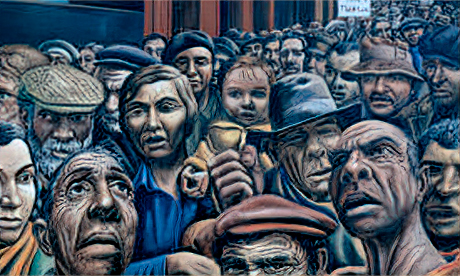Charles Perko admits it will not stand up well as an excuse, but he does offer it up as an “explanation.”
Too many Sundays he has missed Mass, he says, because he was too tired after a 12-hour shift the night before to make it to church.
Workweeks loaded with overtime have not helped, of course.
“After 60- or 72-hour weeks, I’m absolutely exhausted,” he says.
Despite the physical grind and the impact on his family, he, like most of his fellow steelworkers, is reluctant to turn down overtime. “You can’t live on 40 hours a week,” he explains.
Bouncing back and forth between day and night shifts also weakens his resolve to get to Mass. “I think a lot of people in the bottom 40 percent work jobs that have rotating shifts,” Mr. Perko says.
He has other reasons for an at-times tenuous connection to the church.
He is a bit annoyed by those Catholic bishops who denigrate Pope Francis, whom he holds in high esteem as a risk-taker and truth-teller. And as the president of a United Steelworkers local in Pueblo, Colo., he has bristled when church leaders attempt to dictate how he should vote, pushing parishioners toward candidates who may share the church’s position on abortion but otherwise fail to check any political boxes for this union leader.
“When you have someone reading a letter telling you that you’re going to hell because you support the candidate who wants people to eat—that doesn’t jibe with me.”
“When you have someone reading a letter telling you that you’re going to hell because you support the candidate who wants people to eat—that doesn’t jibe with me,” he says.
“I’ve never lost my desire to be in the church,” Mr. Perko adds, “but I had no desire to be part of a growing conservative movement that I saw in the church.”
No time off for Mass?
Mr. Perko’s disaffection reflects an ongoing challenge for the contemporary Catholic Church in the United States. Attendance and affiliation have been eroding steadily since the 1970s for all income brackets, but the sharpest decline has been among the two bottom economic quartiles, according to data gleaned from the U.S. Census American Community Survey.
When Ryan Burge, an assistant professor of political science at Eastern Illinois University, ran the numbers for America, he located the greatest drop-offs in Mass attendance among self-described Catholics in the lowest income bracket.
Those who said they “never attend” Mass jumped from 6 percent in 1972 to just under 25 percent in 2018. In the bracket just above these Catholics, Mr. Burge found another significant leap in never-attenders, from just over 1 percent to 21 percent.
Meanwhile, at the top income quartile, never-attenders went to 13 percent from 4 percent, and in the quartile just below the top, the percentage jumped to 17 percent from almost 2 percent.
Mr. Burge reports that in 2018, some 30 percent of white Catholics who earned $50,000 to $100,000 annually said they attended Mass weekly, similar to the 33 percent of those who earned more than $100,000. Weekly attendance among non-white Catholics in the same income groups was about five percentage points lower.
At the same time, only 23 percent of white Catholics who earned less than $50,000 said they were were attending Mass each week, and non-white Catholics in that income bracket slipped six percentage points in just two years, falling to 21 percent from 27 percent between 2016 and 2018.
Church attendance “is a luxury for many people who are low-income,” Mr. Burge says. “They have to work long hours at multiple jobs, and they just have scheduling conflicts or are just too tired to do one more thing.”
Church attendance “is a luxury for many people who are low-income. They have to work long hours at multiple jobs, and they just have scheduling conflicts or are just too tired to do one more thing.” Continue reading
Additional readingNews category: Analysis and Comment.




